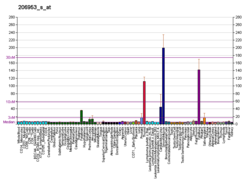Latrophilin 2
Latrophilin 2is aproteinthat in humans is encoded by theADGRL2gene.[5][6]
This gene encodes a member of the latrophilin subfamily of G-protein coupled receptors (GPCR). Latrophilins may function in both cell adhesion and signal transduction. In experiments with non-human species, endogenous proteolytic cleavage within a cysteine-rich GPS (G-protein-coupled-receptor proteolysis site) domain resulted in two subunits (a large extracellular N-terminal cell adhesion subunit and a subunit with substantial similarity to the secretin/calcitonin family of GPCRs) being non-covalently bound at the cell membrane. While severaltranscript variantshave been described, the biological validity of only one has been determined.[6]
See also
[edit]References
[edit]- ^abcGRCh38: Ensembl release 89: ENSG00000117114–Ensembl,May 2017
- ^abcGRCm38: Ensembl release 89: ENSMUSG00000028184–Ensembl,May 2017
- ^"Human PubMed Reference:".National Center for Biotechnology Information, U.S. National Library of Medicine.
- ^"Mouse PubMed Reference:".National Center for Biotechnology Information, U.S. National Library of Medicine.
- ^White GR, Varley JM, Heighway J (Apr 2000). "Genomic structure and expression profile of LPHH1, a 7TM gene variably expressed in breast cancer cell lines".Biochimica et Biophysica Acta (BBA) - Gene Structure and Expression.1491(1–3): 75–92.doi:10.1016/s0167-4781(00)00020-8.PMID10760572.
- ^ab"Entrez Gene: LPHN2 latrophilin 2".
Further reading
[edit]- Südhof TC (2001). "Alpha -Latrotoxin and its receptors: neurexins and CIRL/latrophilins".Annual Review of Neuroscience.24(1): 933–62.doi:10.1146/annurev.neuro.24.1.933.PMID11520923.
- Ushkaryov YA, Volynski KE, Ashton AC (Apr 2004). "The multiple actions of black widow spider toxins and their selective use in neurosecretion studies".Toxicon.43(5): 527–42.doi:10.1016/j.toxicon.2004.02.008.PMID15066411.
- Bonaldo MF, Lennon G, Soares MB (Sep 1996)."Normalization and subtraction: two approaches to facilitate gene discovery".Genome Research.6(9): 791–806.doi:10.1101/gr.6.9.791.PMID8889548.
- Nagase T, Ishikawa K, Suyama M, Kikuno R, Miyajima N, Tanaka A, Kotani H, Nomura N, Ohara O (Oct 1998)."Prediction of the coding sequences of unidentified human genes. XI. The complete sequences of 100 new cDNA clones from brain which code for large proteins in vitro".DNA Research.5(5): 277–86.doi:10.1093/dnares/5.5.277.PMID9872452.
- White GR, Varley JM, Heighway J (Dec 1998)."Isolation and characterization of a human homologue of the latrophilin gene from a region of 1p31.1 implicated in breast cancer".Oncogene.17(26): 3513–9.doi:10.1038/sj.onc.1202487.PMID10030676.
- Kreienkamp HJ, Zitzer H, Gundelfinger ED, Richter D, Bockers TM (Oct 2000)."The calcium-independent receptor for Alpha -latrotoxin from human and rodent brains interacts with members of the ProSAP/SSTRIP/Shank family of multidomain proteins".The Journal of Biological Chemistry.275(42): 32387–90.doi:10.1074/jbc.C000490200.PMID10964907.
- Bjarnadóttir TK, Fredriksson R, Höglund PJ, Gloriam DE, Lagerström MC, Schiöth HB (Jul 2004). "The human and mouse repertoire of the adhesion family of G-protein-coupled receptors".Genomics.84(1): 23–33.doi:10.1016/j.ygeno.2003.12.004.PMID15203201.
- Clark TA, Schweitzer AC, Chen TX, Staples MK, Lu G, Wang H, Williams A, Blume JE (2007)."Discovery of tissue-specific exons using comprehensive human exon microarrays".Genome Biology.8(4): R64.doi:10.1186/gb-2007-8-4-r64.PMC1896007.PMID17456239.
This article incorporates text from theUnited States National Library of Medicine,which is in thepublic domain.





